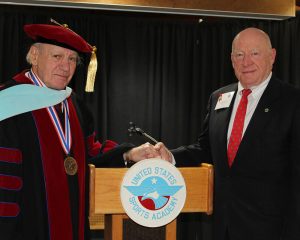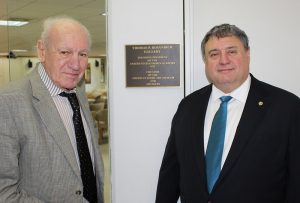 Source: Asama.org
Source: Asama.orgUnited States Sports Academy founder and President Emeritus Dr. Thomas P. Rosandich, left, was presented the 2016 National Honorary Doctorate by Academy trustee Dr. Don C. Wukasch.
DAPHNE, Ala. – Dr. Thomas P. Rosandich, Founding President of the United States Sports Academy and a long-time leader in sport and sport education around the globe, has been awarded a 2016 National Honorary Doctorate from the Academy, which also named its main art gallery in his honor.
Rosandich was presented the Honorary Doctorate by Academy trustee Dr. Don C. Wukasch during the Academy’s Awards of Sport program on campus on 10 November 2016. Rosandich was lauded for his vision and service as Founding President of the Academy and for his leadership during 43 years as president. He continues serving today as President Emeritus.
The next day, the Academy’s Board of Trustees honored Rosandich by naming the “Dr. Thomas P. Rosandich Gallery” for him, recognizing his creation of the American Sport Art Museum and Archives (ASAMA), which has provided cultural enrichment to thousands of people. The trustees acknowledged Rosandich’s appreciation of the relationship between art and sport that led him to create ASAMA, which is located within the Academy building and is one of the world’s leading collections of sport art.
Each year as part of its Awards of Sport program, the Academy presents honorary doctorates to national and international recipients who have distinguished themselves through outstanding contributions to sport. Honorees are presented with a hood, citation, plaque and transcript signifying their honorary degree.
A native of Sheboygan Falls, Wisc., Rosandich founded the Academy in 1972 in response to the poor performance of the United States teams at the Munich Olympic Games that year. Rosandich believed the performance could be traced back to poor administration, lack of medical support and unscientific training and coaching. Concurrently was the publication of the Blythe-Mueller Report that demonstrated the connection between the professional preparation of coaches and the number and severity of injuries that occurred in their athletes. Realizing that the solution to these problems lay in education, Rosandich conceived of the Academy as a special-mission educational institution of sport that today offers degrees at the bachelor’s, master’s and doctoral levels to students around the globe.
Since that day, the Academy has grown into the only accredited free-standing sports university in America. Over the past 45 years, the Academy has conferred thousands of sport-specific degrees to its students and has enriched the lives of countless more through its education and outreach programs that have been delivered in some 65 countries around the world.
Rosandich brought to the Academy a storied career in sport. He starred in football and track and field at the University of Wisconsin-La Crosse, where he graduated with a degree in physical education and history in 1954. His alma mater has recognized his contributions by his induction into the UW-La Crosse Athletic Wall of Fame in 1983, naming him the Maurice O. Graff Distinguished Alumnus in 1989, and honoring him annually by presenting the Rosandich Thesis Award, which recognizes the student with the best master’s degree thesis of the year. Rosandich went on to earn a master’s degree in sport administration from the National School of Sport at the University of Indonesia and a Ph.D. in research at Union Graduate School in Ohio.
Rosandich wrote his doctoral dissertation on the International Physical Fitness Test, which was first introduced in 1964 in Indonesia by the Peace Corps volunteers that Rosandich recruited and brought to that country. The test was further refined and modified in 1977 by the United States Sports Academy staff then working for the Supreme Council for Youth and Sports of Bahrain. The test manual was based on data collected and processed from Arab youth, ages 9 to 19, and provided the nation’s leadership the first ever physical profile of the country’s youth. At the time, it was believed to be the only test battery that measured all of the basic components of all physical activity in speed, strength, suppleness (flexibility and agility) and stamina. The test was adopted by the International Council for Health, Physical Education, Recreation, Sport and Dance (ICHPER-SD) and over the years has been used in more than 21 nations.
Following graduation from UW-La Crosse, Rosandich began a 20-year career of service in the United States Marine Corps reserve, where he coached numerous world record and Olympic track and field athletes. He was the founder and director of the inaugural Marine Corps Schools Relays in Quantico, Va., and was named the All-Marine Track and Field Coach, All-Marine Cross Country Coach and All-Service Coach in 1956. Rosandich was appointed a member of the Military Advisory Committee for the 1956 Olympic Games in Melbourne, Australia.
Between 1956 and 1976, Rosandich coached in some 50 countries preparing national teams for international games as part of the U.S. State Department’s “U.S. Ambassadors of Sport” program. In this role, Rosandich was charged with using sport to elevate America’s relationship with nations around the world. Rosandich served as a national track coach for Malaya, Laos, Singapore, Borneo and Indonesia in Olympiads from 1956-64, attended the 1972 Munich Olympics as a consultant for the Philippines, and served as a representative for Bahrain at the 1984 Olympics in Los Angeles.
Rosandich returned to Southeast Asia in 1960 when he was appointed as the National Track and Field coach for Indonesia. While in Djakarta, Rosandich spent four years developing the Indonesian national teams and preparing them for both the Asian and Tokyo Olympic Games. He also founded the Asian Track and Field Coaches Association, which still exists today. Rosandich also played a pivotal role in the establishment of the Southeast Asian Games, a regional multi-sport event that today brings together 11 nations and as many as 10,000 athletes every four years.
Being an early advocate of using sports for the advancement of American interests, Rosandich developed this model in the Republic of Indonesia and in 1963 succeeded in bringing 32 coaches as Peace Corps volunteers to that island nation. These coaches were assigned to the many islands that make up the archipelago of Indonesia. The core of this group of coaches recently met in North Carolina for their 50th reunion. Also during this period, Rosandich was elevated to become the Chief National Coach of Indonesia and provided oversight for some 35 foreign coaches who hailed primarily from the Eastern Bloc nations.
 Source: Asama.org
Source: Asama.orgThe United States Sports Academy Board of Trustees honored Founding President Dr. Thomas P. Rosandich, left, by naming the “Dr. Thomas P. Rosandich Gallery” for him, recognizing his creation of the American Sport Art Museum and Archives (ASAMA), which has provided cultural enrichment to thousands of people. ASAMA, which is located within the Academy building, is one of the world’s leading collections of sport art. The honoree is shown with his son, Dr. T.J. Rosandich, current President and Chief Executive Officer of the Academy.
An astute observer, Rosandich also learned from these coaches many of the scientific underpinnings for coaching sports that had eluded their American counterparts. Determined to share these observations with his colleagues in the United States, he embarked on building a sport village in the middle of the forests of northern Wisconsin. Ultimately this effort became known as Olympia Sport Village, which was located near Upson, Wisc. At that time it was the only year-round sports training camp in the nation. It developed a national reputation as a running camp in the summer and a ski camp in the winter. This reputation also drew coaches from California to Florida who travelled there to participate in the Olympia Sport Coaching Clinics that eventually became the basis for the Academy’s coaching curriculum.
While the Olympia training camps drew hundreds of aspiring athletes over the years to run in the swamps and up the mountains in the forest, the camp became the center for a variety of other activities as well. With a core of more than 100 runners at Olympia, Rosandich founded the Paavo Nurmi Marathon in 1969. The name of this race was selected in recognition of the large Finnish community that lives in the area. Paavo Nurmi was a Finnish middle- and long-distance runner known as the “Flying Finn,” who at one time held 22 world records and won 12 Olympic medals. This race is still run every August starting in Upson and finishing in Hurley, Wisc.
Given an average snow fall of 150 inches and the best ski hills in the Mid-West, Olympia was a natural for both alpine and Nordic cross-country skiing. In this latter connection, Olympia hosted the U.S. Olympic Biathlon trails for the 1968 Grenoble Games, the United States Biathlon Championships and a USA-Canada dual meet. When the ski camp was not in session, college ski clubs came to Olympia for weekend outings. During a visit by one such club from the University of Wisconsin-Parkside, their administration was fascinated by the activities at Olympia and invited Rosandich to apply for the Director of Athletics and Physical Education at their new university campus in Kenosha. This offer intrigued Rosandich and he accepted.
Once at UW-Parkside, he instantly laid out cross country running trails similar to those found at Olympia. The course is still among the most famous in the United States, as every year the National Association of Intercollegiate Athletics (NAIA) holds its National Championship there. The first national championship held there was the U.S. Track and Field Cross Country Championships which was an upstart organization competing with the Amateur Athletic Union (AAU) at the time.
During his tenure at UW-Parkside from 1967-72, Rosandich founded the Golden Midwest High School Track and Field Championships. He later founded the All-American High School Championships sponsored by Sears, an event that brought the best high school graduates from throughout the United States to compete at Drake University and later at Louisiana State University. Given the work of Rosandich in track and field, he was inducted into the Helms Hall of Fame for his significant contributions to the sport.
In 1972, Rosandich was recruited by the University of Wisconsin-Milwaukee to go to that Division I school. However, his tenure at UW-Milwaukee may have been a low point in his career. Confronted with a new law designed to promote gender equity in sports and school programs entitled Title IX, he made the unpopular decision to drop the football program in order to allocate the necessary resources to comply with the new mandate. As football had to go, so too did the person responsible, and Rosandich resigned and went with it.
At both UW-Parkside and UW-Milwaukee, Rosandich built major physical education and sport facilities. He was also very active in professional organizations such as the National Association of Collegiate Directors of Athletics (NACDA). These activities, combined with his experiences abroad and building sports programs in this country led him to an understanding for the need for an institution dedicated solely to the professional development of sports. Rosandich began laying the groundwork for what was to become the United States Sports Academy while he was at UW-Milwaukee and his resignation from that school provided the impetus to focus on its development. Setting up the first classroom and a sports medicine facility in donated space in Milwaukee in 1972, the Academy offered its first classes drawing on experts in the profession whom he met over the course of his career.
In 1976 two significant events changed the course of the Academy forever: Rosandich signed a major contract to develop a national sports program in Bahrain and the institution relocated to the campus of the University of South Alabama in Mobile. While there, the Academy led the development and installation of South Alabama’s first 400 meter all-weather track, a sports medicine center, a human performance lab, and a fully equipped strength and conditioning center. The Academy also founded Operation Bounce-Back, a cardiac rehabilitation program that is still helping Mobilians who suffer from cardiovascular illness.
The Academy moved to its permanent location on the Eastern Shore of Mobile Bay in Daphne, Ala., in 1986. Another milestone was reached when in 1998 then Governor Fob James dedicated the campus as the home to the American Sport Art Museum and Archives (ASAMA). Founded by Rosandich in 1984, ASAMA is dedicated to the preservation of sports art, history, and literature. Since its founding, ASAMA has become one of the world’s largest sport art museums with a collection that is composed of nearly 2,000 works of sport art across a variety of media, including paintings, sculptures, assemblages, prints and photographs.
Though fully engaged in building the Academy into America’s premier school of sports, Rosandich still found the time to contribute to the profession in many ways. In the mid-1990s, Rosandich served as president of the U.S. Team Handball Federation and led that both the men’s and women’s teams to the 1996 Atlanta Olympic Games (this was the 100th anniversary of the Modern Olympic Games). Concurrently, working with the great Spanish artist Cristóbal Gabarrón and Juan Antonio Samaranch, the President of the International Olympic Committee, Rosandich brought The Atlanta Star to the Olympic Park in Atlanta, Ga. The Atlanta Star was composed of 26 pillars, each depicting an Olympiad of the summer games. This was the biggest art project ever staged in conjunction with any Olympiad. Today, The Atlanta Star is on display in Geneva, Switzerland.
Rosandich, who served as a member on the United States Olympic Committee (USOC), also served on the USOC commissions for education, athlete identification and international relations, which earned him the USOC President’s Award for contributions to the organization. Rosandich also served on the International Olympic Committee’s Commission for Culture and Olympic Education for some ten years. For his work in the Olympic Movement, Rosandich was awarded the highest International Olympic Committee honor, The Olympic Order, in 1997. The award is “bestowed upon persons who have illustrated the Olympic ideal through action, who have achieved remarkable merit in the sporting world, or who have rendered outstanding services to the Olympic cause.” The following year, Rosandich was elected to the executive committee of the International World Youth Games Committee. Among the many other honors Rosandich has received include the Order of Bahrain, that country’s highest honor, and the Pestalozzi Fellow Award from the European University in Switzerland.
After founding the Academy in 1972, Rosandich served as its president and chief executive officer for 43 years until 2015, when his son, Dr. T.J. Rosandich, was named President. Since then, Rosandich has served an active role as the Academy’s President Emeritus.
While Rosandich has stepped down from his role as president of the Academy, his legacy is that it continues to serve the profession as an independent, non-profit, accredited, special mission Sports University created to serve the nation and world with programs in instruction, research, and service. The role of the Academy is to prepare men and women for careers in the profession of sports.
The Honorary Doctorate program is part of the United States Sports Academy’s Awards of Sport, which each year serve as “A Tribute to the Artist and the Athlete.” The Academy presents the awards to pay tribute to those who have made significant contributions to sport, in categories as diverse as the artist and the athlete in several different arenas of sport. The Academy’s American Sport Art Museum and Archives annually recognizes these men and women through its Sport Artist of the Year, Honorary Doctorates, Medallion Series, Distinguished Service Awards, Outstanding Athletes, and Alumni of the Year awards.
image sources
- President-Emeritus-Rosandich-Honorary-Doctorate-from-Academy-Trustee-Dr.-Don-Wukasch-300×240: Asama.org
- IMG_0462-cropped-300×203: Asama.org
